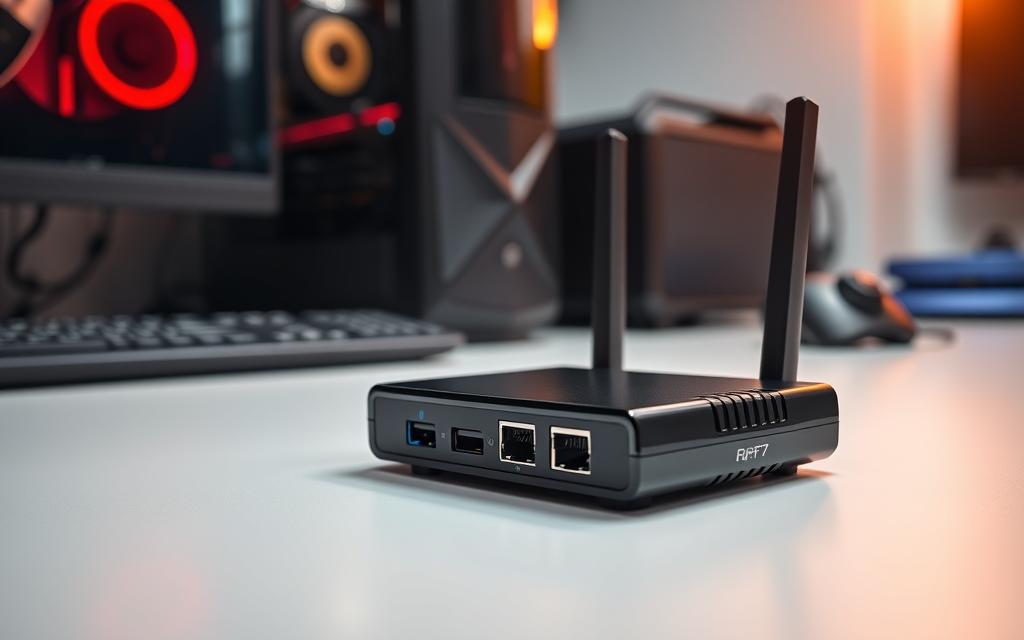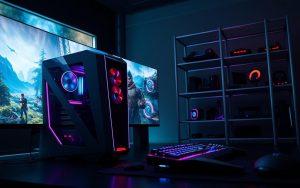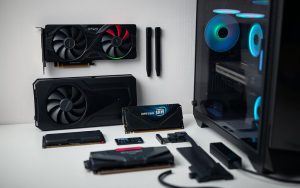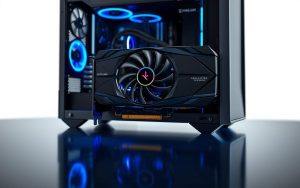Table of Contents
Modern gaming setups often face connectivity challenges. Many desktop systems lack built-in Wi-Fi, forcing users to explore external solutions. Surprisingly, 53% of prebuilt gaming computers don’t include this feature.
Before purchasing a network adapter, check your system’s capabilities. The Device Manager reveals whether your device already has a wireless network adapter. Compatibility with your motherboard and router matters just as much as speed requirements.
High-performance options like the TP-Link Archer TXE75E showcase Wi-Fi 6E advancements. While wired internet offers stability, wireless flexibility enhances mobility. The right choice depends on your setup and gaming preferences.
Do I Need a Wireless Adapter for My Gaming PC?
Gaming enthusiasts often debate the necessity of additional hardware for connectivity. A wireless network adapter translates radio signals into digital data, enabling seamless internet access. For desktop systems without built-in Wi-Fi, this device becomes essential.
Understanding the Role of a Wireless Adapter
This hardware bridges the gap between your computer and router. It comes in two main types: PCIe and USB. For example, the TP-Link Archer TXE75E leverages Wi-Fi 6E for faster speeds and reduced latency.
Key features to consider include compatibility with your motherboard and router. USB 3.0 ports or PCIe x1 slots are common requirements. Always check your device specifications before purchasing.
When a Wireless Adapter is Essential
Certain scenarios make this hardware indispensable. If your router is more than 30 feet away, a network adapter ensures stable connectivity. Rental properties with wiring restrictions also benefit from wireless solutions.
Additionally, the 6GHz band, exclusive to Wi-Fi 6E, requires Windows 11 for optimal performance. This band reduces packet loss by 47%, making it ideal for gaming.
Gaming Performance: Wired vs. Wireless
Ethernet remains the gold standard for competitive gaming, offering less than 1ms latency. However, wireless network technology has advanced significantly. Wi-Fi 6 reduces latency to 2ms, compared to Wi-Fi 5’s 10ms.
Here’s a quick comparison of wireless bands:
- 2.4GHz: Wider coverage but slower speeds.
- 5GHz: Faster speeds with moderate coverage.
- 6GHz: Ultra-fast speeds with minimal interference.
For troubleshooting, the Windows Control Panel provides tools to diagnose network adapter issues. This ensures your setup remains optimized for gaming.
Alternatives to a Wireless Adapter
Exploring alternatives to traditional connectivity solutions can enhance your gaming experience. While a wireless network adapter is a popular choice, other options like Ethernet, USB adapters, and smartphone tethering offer unique benefits. Each method has its strengths, depending on your setup and needs.
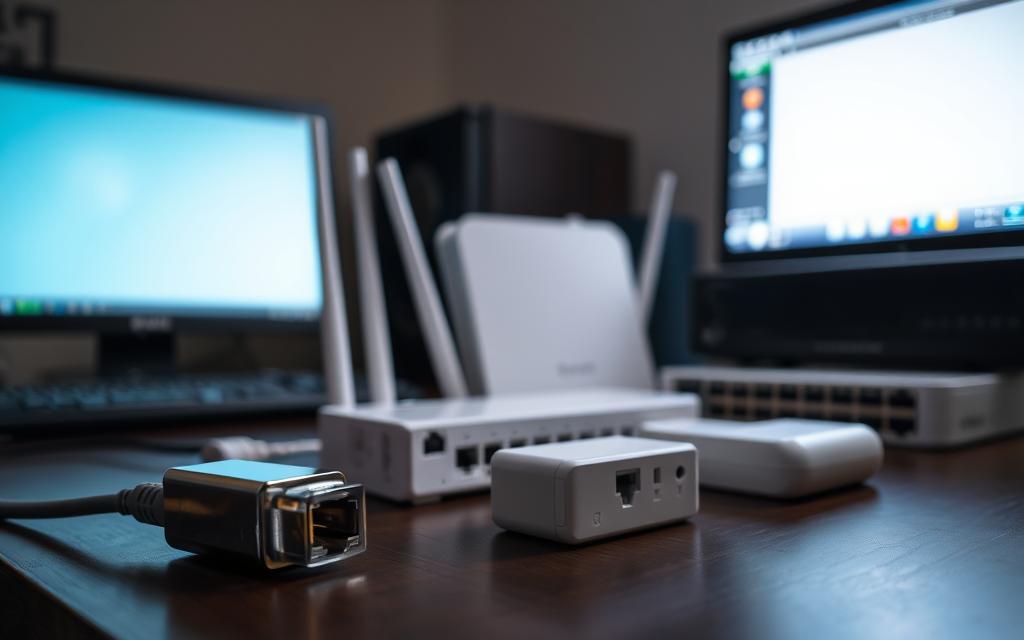
Using Ethernet for Stable Connectivity
Ethernet remains the most reliable way to connect your computer to the internet. A wired connection ensures minimal latency, making it ideal for competitive gaming. Cat6 cables support speeds up to 10Gbps, outperforming even Wi-Fi 6E’s theoretical maximum of 9.6Gbps.
For latency-sensitive games, Cat6 is the better choice over Cat5e. It’s also cost-effective, with cables starting at $15. Proper router placement can further optimize your network performance, ensuring a seamless gaming experience.
USB Wi-Fi Adapters: A Quick Fix
USB adapters provide a convenient solution for temporary setups. Devices like the Netgear Nighthawk A8000 offer 1200Mbps throughput, making them suitable for high-speed gaming. Plugable USB 3.0 adapters are another excellent option for quick and easy internet access.
These adapters are plug-and-play, requiring no complex installation. However, they may not match the performance of a dedicated network adapter or Ethernet connection. For gamers on the go, they’re a practical choice.
Tethering Your Smartphone for Internet Access
Smartphone tethering is a versatile way to connect your desktop to the internet. Both Android and iOS devices support this feature, allowing you to share your mobile data. The setup process is straightforward, involving a few taps in your phone’s settings.
However, be mindful of data caps. Streaming 1080p content can consume up to 500MB per hour. For short-term use or emergencies, tethering is a viable alternative. It’s also a great way to test your network before committing to a permanent solution.
How to Set Up a Wireless Adapter for Your Gaming PC
Setting up a wireless network adapter for your gaming PC can significantly improve your online experience. Whether you’re upgrading your desktop or troubleshooting connectivity issues, this guide will walk you through the process.
Choosing the Right Wireless Adapter
Selecting the right device is crucial for optimal performance. Internal PCIe adapters like the TP-Link TX3000E offer higher speeds, while external USB options like the Netgear A8000 provide flexibility. Consider your motherboard’s compatibility and available slots.
For advanced networking, look for Wi-Fi 6E support. The Intel AX210 chipset outperforms the AX200, offering faster speeds and reduced latency. Always check your router’s capabilities to ensure seamless integration.
Step-by-Step Installation Guide
Begin by identifying the PCIe slot on your motherboard. For USB adapters, ensure you’re using a USB 3.0 port for maximum speed. Once connected, install the drivers using the Device Manager in Windows.
If you encounter issues like code 43 errors, reinstall the drivers or check the antenna positioning. Proper installation ensures your network adapter functions at peak efficiency.
Optimizing Your Wireless Network for Gaming
To enhance your gaming experience, configure your router’s 5GHz channel to avoid interference. Implement WPA3 encryption in the router admin panel for added security. Place your router at least 5 feet off the ground and away from microwaves or other electronic devices.
Enable Quality of Service (QoS) to prioritize gaming traffic. This ensures minimal latency and a smoother connection. Regularly update your device drivers to maintain optimal performance.
Conclusion
Choosing the right connectivity solution for your setup requires careful consideration. Latency tolerance and physical constraints play a significant role in determining the best way to enhance your network performance. Wi-Fi 6E stands out as a future-proof investment, offering faster speeds and reduced interference.
Hybrid setups, combining Ethernet for your primary desktop and wireless for portable devices, provide flexibility and stability. Before finalizing your choice, verify compatibility with your device and ensure proper security protocols are in place.
For troubleshooting, the Windows Network Troubleshooter is a valuable tool to resolve connectivity questions. As technology evolves, staying informed about advancements like Wi-Fi 7 ensures your setup remains optimized. Explore more about WiFi adapter options to make an informed decision.
FAQ
Does a gaming PC require a wireless adapter?
Not always. If your motherboard has built-in Wi-Fi or you use an Ethernet cable, a separate adapter isn’t necessary. However, for wireless connectivity without built-in support, an adapter is essential.
How does a wireless adapter affect gaming performance?
A high-quality adapter ensures stable connections with minimal latency. Wired Ethernet still offers lower ping, but modern Wi-Fi 6 adapters provide competitive speeds for most gaming needs.
Can I use a USB Wi-Fi adapter instead of an internal one?
Yes. USB adapters are plug-and-play solutions, ideal for quick setups. However, PCIe adapters often deliver better performance with stronger signals and lower interference.
What’s the difference between Wi-Fi 5 and Wi-Fi 6 adapters?
Wi-Fi 6 offers faster speeds, reduced latency, and better performance in crowded networks. For future-proofing, a Wi-Fi 6 adapter is recommended if your router supports it.
How do I install a wireless adapter on my gaming PC?
For PCIe adapters, power off your PC, insert the card into an available slot, and install drivers. USB adapters simply plug into a free port, with automatic driver installation in most cases.
Can I use my smartphone as a wireless adapter?
Yes, via USB tethering or mobile hotspot. However, this isn’t ideal for gaming due to higher latency and potential data limits compared to dedicated adapters.
Where can I check if my PC already has a wireless adapter?
Open Device Manager in Windows and expand Network adapters. Look for terms like “Wi-Fi” or “Wireless” to confirm built-in support.


